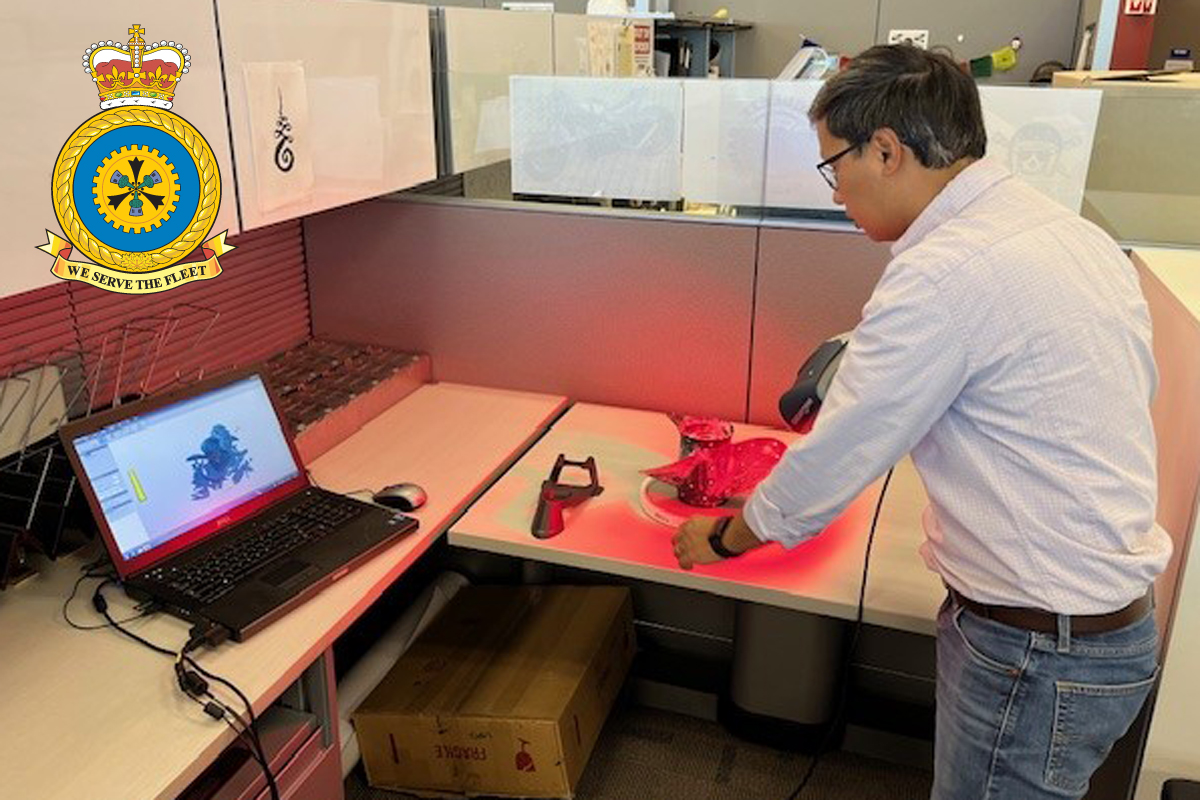Naval Innovation: 3D scanning revolutionizes ship repair and manufacturing
By Lookout Production on Jun 27, 2024 with Comments 0

Si Thu Naing, supervisor of the Drawing Office within Fleet Maintenance Facility Cape Breton’s Naval Architecture subsection, trains a Camosun College Mechanical Engineering Co-op student in capturing 3D point cloud data using CreaForm 3D handheld scanner.
Kate Bandura,
Lookout Editor
—
In a remarkable leap for maritime technology, Fleet Maintenance Facility Cape Breton (FMFCB) is harnessing the power of 3D scanning to transform ship repair and manufacturing. This cutting-edge technology not only streamlines operations but also promises significant time and cost savings for the Royal Canadian Navy (RCN).
“By streamlining the repair process and reducing downtime, 3D scanning helps FMFCB reduce costs and avoid unnecessary delays due to the supply chain, enabling us to promptly respond to operational requirements of the RCN while ensuring vessels return to service faster,” says Si Thu Naing, supervisor of the Drawing Office within FMFCB’s Naval Architecture subsection.
The star of this technological show is the CreaForm 3D handheld scanner, a device capable of capturing intricate details with an astonishing accuracy of up to 0.040mm; that’s less than half the diameter of a typical human hair.
In a recent demonstration, Naing trained Dawson Mork, a co-op student from Camosun College’s Mechanical Engineering program, in the art of capturing 3D point cloud data. Using a small propeller dotted with tiny surface targets, the pair showcased how the scanner can create a perfect digital twin of complex shapes.
But the applications of this technology extend far beyond simple measurements. FMFCB team have successfully used 3D scanning to accurately measure the propeller of a Victoria class submarine, a task that would have been painstakingly difficult and time-consuming with traditional methods.
Perhaps even more exciting is how 3D scanning is revolutionizing the prototyping process.
“In the past, creating a prototype could be a costly adventure, requiring tooling, casting, or molding,” Naing explains. “Now, we can scan an existing part or design and print a prototype in a matter of hours.”
To illustrate this, Naing proudly displays a 3D-printed prototype created using data from the CreaForm scanner and a Stratasys 3D printer. The result is a precise replica made of ABS plastic, produced at a fraction of the cost and time of traditional methods.
The implications of this technology are far-reaching, Naing says. It enables the rapid production of custom parts and tools, a capability that could prove invaluable during naval operations or in remote shipyards. Moreover, it has the potential to significantly reduce dependency on complex supply chains, allowing for faster responses to operational requirements.
As Naing is quick to point out, this technological leap is very much a team effort.
“FMFCB Engineering Department does all the design work to prepare the 3D models,” he says. “Once that’s done, it’s ready for additive manufacturing process.”
With this powerful combination of 3D scanning and printing at their disposal, FMFCB is sailing into a future where ship repair and manufacturing are faster, more precise, and more efficient than ever before. As navies worldwide grapple with the challenges of maintaining complex fleets, innovations such as these may well be the key to staying afloat in the 21st century.

Quarter turn sector gear prototype captured using CreaForm scanner. Photos submitted
Filed Under: News Release • Top Stories
About the Author:





